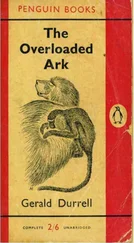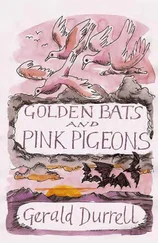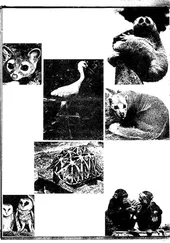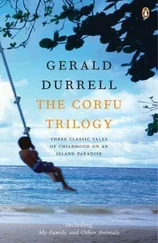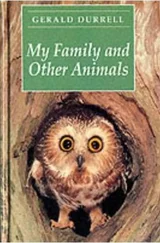Mother’s susceptibility to the paranormal showed no signs of abating, for this place too turned out to be haunted, one ghost being visible, two others audible. The first took the form of a woman who appeared at the foot of Mother’s bed when she woke from a siesta one day. The woman smiled at Mother, then faded slowly away. She appeared again a few weeks later, this time witnessed by Gerald’s cousins Molly and Phyllis, who came running into the kitchen shouting, ‘Auntie, Auntie, there’s a strange lady in your room.’
The second ghost took the form of a voice that kept telling Mother to put her head in the gas oven, and the third manifested itself in Larry’s room one night when he was playing in a jazz band up in town. In Larry’s room reposed the great teak roll-top desk that his father had had built to his own design. When the roll-top was raised or lowered the noise, Gerald recalled, was indescribable. That night, while Mother lay smoking in bed, waiting anxiously for Larry’s return, she heard the unmistakable racket of the roll-top opening and closing. ‘Taking me firmly by the hand,’ Gerald was to recount, ‘we went down the length of the flat, listening to the constant clatter of the lid being pulled shut and then opened again, but the moment we opened the door and looked into the room there was nothing to be seen.’
It was in the garden of the Queen’s Hotel, while he was trying to catch birds by putting salt on their tails, that Gerald first came face to face with the more sensual side of life, in the form of a beautiful young woman called Tabitha. ‘She had big, melting brown eyes,’ he recalled, ‘brown and glossy as new horse chestnuts, a wide smile, brown hair bobbed and with a fringe like a Christmas cracker.’ Before long Tabitha was looking after him in her tiny flat whenever Mother went off house-hunting. She had a cat called Cuthbert and two goldfish called Mr Jenkins and Clara Butt, as well as a lot of gentlemen friends who came and went and seemed to spend a shorter or longer time in her bedroom – to talk business, she told her young friend.
‘I loved the days I spent with Tabitha,’ Gerald wrote in his private memoir:
In fact I loved Tabitha very much. She was so gentle and gay, her smile engulfed you with love. She smelt gorgeous too, which was important to me, since Mother smelt gorgeous as well. She was not only very sweet and kind but very funny. She had a squeaky wind-up gramophone and a pile of records of Harry Lauder and Jack Buchanan, so we would clear away the furniture and Tabitha would teach me how to do the Charleston and the waltz. At times we went round and round so fast that eventually we would collapse on the sofa, she with peals of laughter and me giggling like a hysteric. Tabitha also taught me lots of songs, including one which enchanted me:
Iz ’e an Aussie, iz ’e, Lizzie?
Iz ’e an Aussie, iz ’e, eh?
Iz it because ’e iz an Aussie
That ’e makes you feel this way?
But alas, somehow or other Mother got to hear of Tabitha’s business associates and my visits to her flat were ended. So Tabitha’s lovely brown eyes and wonderful smell disappeared from my world, and I mourned the fact that I could no longer waltz and Charleston and sing silly songs with this enchanting girl.
Looking back in later years, it struck Gerald as odd that Mother should have been so prim. ‘After all,’ he noted, ‘she was rearing a brood of offspring who became sexually precocious and pursued their own interests with the relentlessness of dynamos. Still, her fledglings managed to erode her Victorian attitudes and train her into more broad-minded ways, so that when, at the age of twenty-one, I went home one weekend with a girlfriend, I found a note from my mother which said: “I have made up two beds, dear, and the double bed, since you didn’t tell me whether you are sleeping together or not. The sheets are aired and the gin is in the dining room cupboard.”’
It was while living at the Queen’s Hotel annexe that Mother got to know the Brown family – a matriarchy of English provenance who had recently come over from America, consisting of Granny Richardson, her daughter Mrs Brown, and Mrs Brown’s young daughter Dorothy. Like the Durrells, the Browns had a garden flat at the hotel, and the two mothers soon became good friends, for both were exiles who had returned to a foreign motherland. Dorothy Brown was eleven when she first encountered Gerald, who had just turned five. ‘He was a bright little spark,’ she recalled, ‘and even then he was very fond of animals. When our cat had kittens he was always there on the doorstep, clamouring to see them. He was very much a mother’s boy and always terribly fond of her. As far as he was concerned she could do no wrong.’
Like Louisa Durrell, the Browns were looking for a house to buy, and finally settled on Bournemouth, a salubrious seaside resort on the south coast, stuffed with decaying ex-members of His Majesty’s Forces and genteel ladies eking out modest pensions, but warmer and sunnier than most towns in England, and surrounded by beautiful countryside. Mother decided to follow her friends’ example and move to Bournemouth, and early in 1931 the family became the proud possessors of Berridge House, at 6 Spur Hill, Parkstone, complete with a butler, a housekeeper and two servants. This marked the beginning of the Durrells’ close association with Bournemouth, which has lasted to the present day.
Berridge House was a huge Victorian mansion standing in four acres of grounds, part woodland, part orchard, with a lawn on which two games of tennis could be played at once and a herbaceous border which was, Gerald remembered, ‘slightly wider than the Nile and home to nearly every known weed, with the exception of Mandrake’. When Mother was asked if the house was not a trifle large for a widowed lady and a six-year-old boy – Margaret was now at Malvern, Leslie at Dulwich and Larry at a crammer’s – she answered, rather vaguely, that she had to have room for her children’s friends. To the young Gerald the place looked like a gigantic dolls’ house, with a bewildering quantity of bedrooms, bathrooms and attic rooms, a huge drawing room, dining room and kitchen, a cellar and a parquet-floored basement ballroom that ran the length and width of the house. On rainy days this vast ballroom was his playroom, where he could indulge in ingenuity and uproar without knocking anything over or disturbing anyone upstairs.
To celebrate the move Mother bought Gerald a Cocker spaniel, the first dog of his very own. It arrived in a cardboard box, and when Gerald opened it the creature inside took his breath away – ‘a dog all soft and squidgy, with hair the colour of ripe corn and big brown eyes and a loving disposition’. Gerald named the dog Simon, and from the moment he lifted him from his cardboard box he became his devoted companion.
There was no comparable companion for Mother, however, and the reality of her lonely state began to take its toll of her. ‘The difficulties of living in a great, echoing, empty house with only a small boy as a companion began to tell on Mother’s nerves,’ Gerry was to write in his memoir. She devoted herself to her cooking and teaching Gerald how to cook, and to tending the herbaceous borders in the garden, but then came the evening, and solitude. ‘She was lonely,’ Gerald wrote, ‘and she took to mourning the death of my father in earnest with the aid of the Demon Drink, resorting to the bottle more and more frequently.’
It helped, perhaps, that Gerald shared her bed with her. ‘At the end of the day I would have my bath and then, with a clothes brush, I would climb into the bed that I shared with Mother and dust it carefully to make sure there was not a speck of dust anywhere. Then Mother would come to bed and I would curl up against her warm body in its silk nightgown and frequently I would wake to find myself pressed up against her in a state of arousal.’ For many years to come, mother and child were to remain closer to one another than to any other human beings.
Читать дальше


